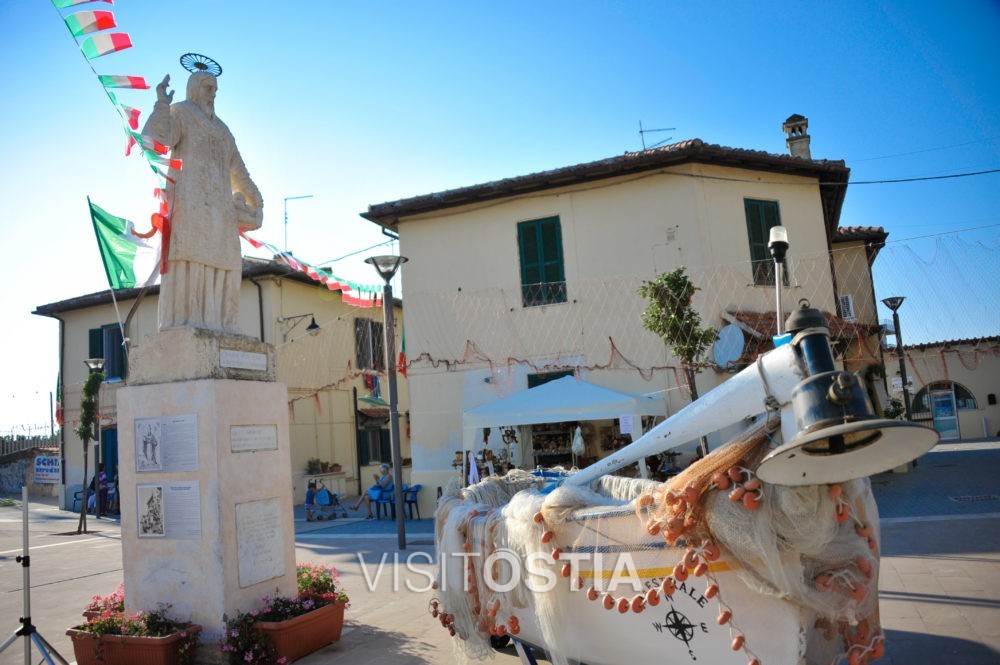The Borghetto dei Pescatori (the Fishermen’s village) is a small settlement of six two storeys buildings, located in Eastern Ostia, next to the Canale di Fusano (Canale dello Stagno, the Fishermen’s canal) just by the beach.
Since a few years this area is pedestrians and included in the eco-touristic itineraries along the roman coast for its interesting setting, being in a location that includes the pine forest, a coastal pond area and the sea shore. The village is also well known because of the local restaurants that propose a sea food based traditional cuisine.
The main square of the village is often set for local markets and exhibitions but the most important happening is definitely the Sagra della Tellina (the Festival of Cockles) a traditional festival very famous for the excellent food proposal based on the small clams, served in an informal and festive environment, that animates Ostia Lido near the end of Summer.
The festival has actually a religious motive as well: infact the statue of San Nicola set in the main square, is moved by a procession of believers on a fishing boat and brought next to Il Pontile (the pier) where the ceremony ends: a crown of flowers into which 2 rings are bond, is thrown into the water then retrieved by a fisherman, to symbolize the marriage between the Virgin and the sea.
The statue of San Nicola is the symbol of the Borghetto: infact it comes from the facade of the Church of Saint Nicholas in Bari where it was taken in 1920’s during the restauration of the structure that had to restore the original medieval aspect of the church. In 1930 the statue was moved to the Borghetto and with a ceremony put next to the fishing boats only to be placed in its current location a few years later.
The history
The history of the Borghetto is actually rich in happenings and anecdodes: between the end of 19th century and the beginning of the 20th, the area becomes a settlement for a small group of fishermen, mostly moving in from the Southern Latium and Campania (Anzio, Monte di Procida, Minturno and Mondragone). Initially the population used to live in poor huts built using salvage materials from the surrounding area, replaced around 1920’s by wooden shacks still built on the shore on the Eastern side of the canal.
As the oldest residents of the Borghetto like to tell to whom is interested in hearing their stories, in 1932 (on Sept. 20th to be precise) the Fortune cast its light on the village: on that day Benito Mussolini emptied the fuel tank of his boat, just infront of the canal and Nicola Schiano Moriello one of the fishermen, promptly went to help, towing the boat in the village. As Benito Mussolini realized how poor was the condition of the people living in the shaks near by, he suggested to the fisherman to speak to Margherita Sarfatti the famous writer and art critic (with whom Mussolini had a love affair) who, at that time, used to spend time at the bathing resort Roma, where the fisherman used to work in Summer as a lifeguard. So, when the time to extend the promenade of Ostia towards East came and the fishermen were supposed to leave their shaks to return to their towns of origin, thanks to the intervention of Benito Mussolini, who was reminded by Margherita Sarfatti of the promise made, instead a new village was built to give proper houses to the community of fishermen.
The Giovannetti brothers construction co., very active at that time (e.g.: the Fire station of Ostia, the bathing resort Lega Navale, the remodelling of Canale Fusano with the boathouse etc.), was entrusted with the task of building the Fishermen’s village. The job was completed very quickly, taking just about 50 days, thanks to the commitment of the laborers who used to work also during the night at the light of the lampare (the lamps used on fishing boats) so the houses were assigned on April 1933; the church was finished in 1939 instead.







